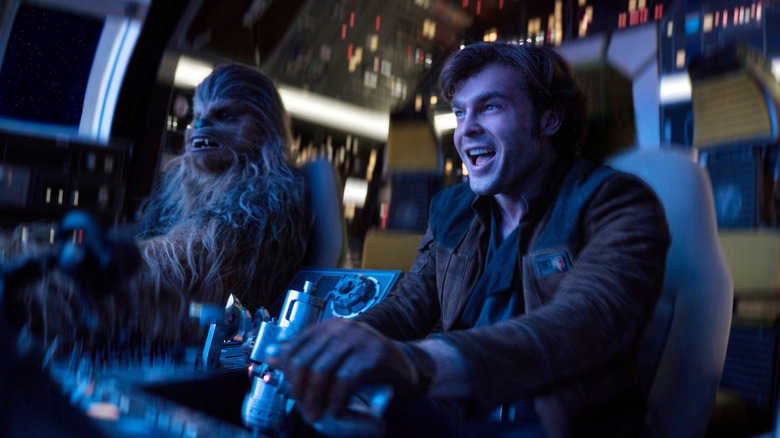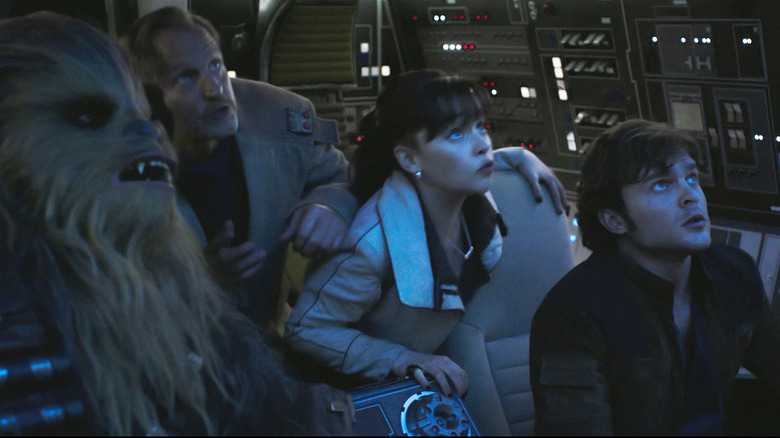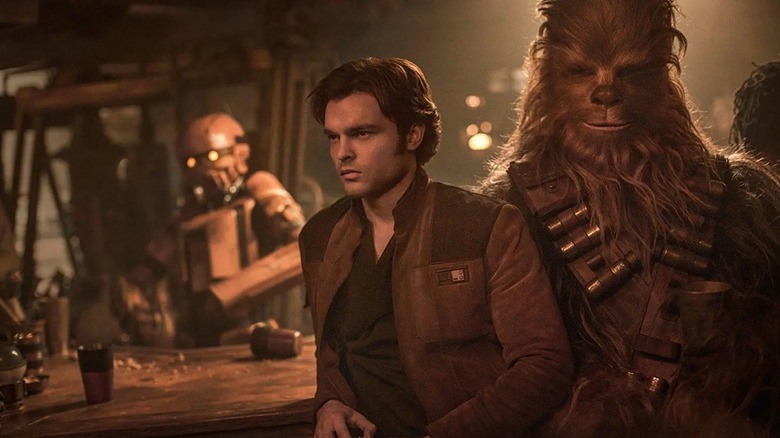Solo: A Star Wars Story Used The Oldest VFX Trick In The Book To Create The Kessel Run
This post contains minor spoilers for "Solo: A Star Wars Story."
Every "Star Wars" fan knows about Han Solo's not-so-humble boast about the Millenium Falcon, a ship that purportedly "made the Kessel Run in less than 12 parsecs." Although this sounds cool, it is a rather vague descriptor that is challenging to visualize. After all, a parsec is a unit of distance, not time, where one parsec is roughly equivalent to 3.26 light years. Even without diving into the scientific nuances of the concept, it is understandable why Solo's claims became a topic for debate and discussion, giving rise to fascinating theories over the years. However, "Solo: A Star Wars Story" effectively answers all our questions about the Kessen Run discourse by approaching Han's boast in ways that are interesting and grounded in practicality.
For quick context, Han (Alden Ehrenreich) and co. need to evade an Imperial blockade in "Solo" and get to Savareen before the coaxium explodes, fueling the need to make the Kessel Run within a narrow temporal window. Lando Calrissian (Donald Glover) states that anything less than 20 parsecs is impossible, but Han decides to pilot the Millenium Falcon through the Maw, a dangerous gamble that pays off with the aid of L3-37's navigation charts. By contextualizing Han's canonical boast about the Kessel Run as a feat that hinges on taking the shortest route as opposed to the safest one, "Solo" puts the parsec debate to rest while still retaining the validity of Han's formidable skills as a pilot. But how did the VFX team in "Solo" pull this scene off?
Rob Bredow, the visual effects supervisor for "Solo," once told Vulture about filming the Kessel Run sequence "as a single continuous experience," where a standard VFX trick was used to achieve an impressive sense of seamlessness.
Solo's Kessel Run employed old-school VFX and cutting-edge tech
Bredow explained that the whole Kessel Run sequence was staged "end-to-end live," with all the contributing aspects, including lighting, VFX, and other cues being executed on the fly, where a standard (and clever) use of rear projection, along with cutting-edge tech from Industrial Light & Magic (ILM), helped bring the sequence to life:
"We wrapped an entire 180-degree screen around the cockpit of the Millennium Falcon, and had multiple projectors throwing media onto that using rear projection, one of the oldest tricks in the book. But we used new technology from ILM, creating an entire world of the Kessel Run in high resolution to be put on those screens. When the actor pulls the level to go into hyperspace, they really see the stars bleeding out like that."
This level of detail helped enhance actor immersion, and the idea of a 20-minute-long continuous take helped refine the finer details of the sequence. Director of Photography Bradford Young worked with his gaffing team while "lighting and media cues" were employed simultaneously, and the Millennium Falcon was "about 12 or 15 feet in the air on a gimbal" that could be moved or spun around as was convenient. Although the physical space in which the shot was filmed was somewhat cramped, the sheer scale and scope of the sequence were successfully conveyed with the help of impressive rear projection:
"One of the fun things that rear projection allowed was a fresh compositional element: The shot where Han first walks into the cockpit, with L3 and Lando sitting at the controls, you see Han's face light up when they jump into hyperspace. Better yet, you can see the reflection of the stars in his eyeballs."
A series of spontaneous, on-the-fly ideas
The Kessel Run sequence, per Bredow, was a labor of love that could only be made possible due to the exchange of spontaneous ideas and suggestions that flowed between the VFX and the camera departments, who worked meticulously to tweak certain aspects to glean whether it would add to the sequence in meaningful ways. Bredow describes this collaborative process as "pretty fun":
"We'd be sitting there, and Bradford [Young] would say, 'Oh, that blaster fire, can that be backlit?' We could make these changes on the fly that would normally happen in post. The blaster fire [...] could be moved, changed in frequency, color, shape. Writer Jon Kasdan would send us new pages at two or three in the morning — we wanted to be ready for whatever came our way. It was pretty fun!"
A similar approach was extended to filming some of the other dramatically oriented scenes in "Solo," such as the train heist, which was shot in varying iterations to test how folks would practically move or react on top of a moving train. Although this sequence was ultimately shot on a soundstage, the groundwork was set with stuntpersons simulating the scenario to better understand technical aspects like wind velocity or bodily movements in this specific situation, so that actors could use those experiences as references "in a controlled environment" (via StarWars.com).
While "Solo: A Star Wars Story" bombed at the box office and was mostly treated with ambivalence, the film's visual artistry, which is a combination of time-tested practical movie magic and state-of-the-art technological innovation, deserves more recognition. Moreover, the film does the impossible: it charts the course for the most thrilling, impressive Kessel Run that we know of in "Star Wars" history.


